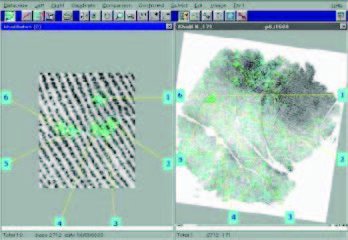
PrintQuest™ Systems include both the Automated Fingerprint Identification and Automated Palmprint Identification capabilities.
Law enforcement officers in Raleigh, North Carolina arrest and bring suspects into the Wake County Detention Center hundreds of times a week. Staff members of Raleigh/Wake City-County Bureau of Identification (CCBI) collect fingerprints, photographs, and DNA from arrestees during routine booking procedures.
In one case, using an innovation created by SPEX Forensics, a division of ��������ֱ�� Instruments, a suspect was subsequently linked by fingerprints to 32 different outstanding felony cases.
Wake County, with a population of 1.1 million, houses North Carolina’s capital city, Raleigh. Wake County is one of the country’s fastest growing counties. CCBI is Wake County’s dedicated forensic service provider for over 50 law enforcement agencies and is committed to maintaining the latest and most effective technologies available.
��������ֱ��’S SPEX Forensics’ AFIS-APIS system is one of the technologies impacting the effectiveness of forensic investigations in Wake County. Short for Automated Fingerprint/Palm Print Identification System, the efficacy of identification technology made possible through this system plays a vital role in the ability of Wake County law enforcement agencies to solve active as well as cold cases. It’s been a game-changer for this identification bureau.
“This system has made the biggest impact in crime scene evidence as anything I’ve ever dealt with,” said Investigations Division Deputy Director Andy Parker, a 30-year law enforcement veteran and former latent print examiner.
CCBI purchased the first SPEX Forensics AFIS-APIS System, called PrintQuest®, in 2006. Immediately, known standards from all Wake County arrestees were entered into this local system at the same time they were submitted to the state/federal systems. Populating fingerprints and palm prints at the rate of approximately 30,000 arrestees a year, CCBI sought to take advantage of the advanced palm print searching capabilities provided by this technology and entered known palm print arrest standards dating back to the 1970s.

In 2006, relying solely on the state AFIS system and manual identifications, CCBI effected 244 individual subject identifications from finger and palm prints recovered from crime scenes. Restricted by resources to access the state AFIS system resulted in what would prove to be limited identification potential. Upon the implementation of the PrintQuest® system and staff’s growing familiarity with it, identifications more than doubled in 2007 with a total of 528 identifications. As the effectiveness of the system became quickly apparent, the agency placed significant reliance on the PrintQuest®
system, resulting in 1,016 individual subject identifications in 2008.
The PrintQuest® algorithm is a very successful search tool,” CCBI Crime Laboratory Deputy Chris Stark said.
Since its implementation in 2006, CCBI’s PrintQuest® has made 33,179 latent finger and palm print identifications. It currently houses and actively searches over 129,000 unidentified latent crime scene print impressions against new arrestees.
Contributing to the overwhelming success is what CCBI Director Sam Pennica refers to as the “triangle of identification.” CCBI operations include the collection of all Wake County arrestee fingerprints, the collection of latent impression evidence from crime scenes, and the forensic analysis of impression evidence through the Latent Print Unit. The combination of one agency maintaining operational responsibility for all three factors allows CCBI to manage the quality of all aspects of the fingerprint analysis process.
An additional contributing factor to this program’s success is that CCBI Crime Scene Investigators recover latent impression evidence from 60 percent of Wake County crimes scenes.
PrintQuest® gets to work as soon as a Latent Print Examiner takes an unknown finger or palm print from a crime scene and enters it into the system. The system identifies individual characteristics within the print impression and creates a print-specific digital signature processed by a proprietary algorithm. The algorithm searches against all known finger and palm print standards maintained in the database. Currently, CCBI’s PrintQuest® database houses over 416,000 known finger and palm print standards from Wake County arrestees, maintained and searched by 10 Latent Print Examiners, using 11 workstations.
Roughly half of the identifications made occur on what is referred to as the “front end”. This indicates that upon entering an unknown crime scene print, an identification is made based on an arrest print already existing in the database.
The other 50 percent of identifications are what are referred to as “reverse hits”. These are identifications made when known arrest prints hit to unknown crime scene prints already in the database.
A contributing factor of the high success experienced at CCBI is that approximately one-third of all identifications made result from palm print evidence.
“These cases are sometimes many years old and we still effect identifications and report back to the law enforcement agency,” Pennica said.
In a recent case, a 13-year old juvenile suspected of a violent felony was fingerprinted by order of the Court and the prints were placed into the PrintQuest® system. It linked the juvenile to 65 unsolved felony cases.
To meet the demands of Wake County’s rapidly growing population, CCBI will continue to utilize PrintQuest® technology to serve the criminal justice system.
Masz pytania lub prośby? Skorzystaj z tego formularza, aby skontaktować się z naszymi specjalistami.